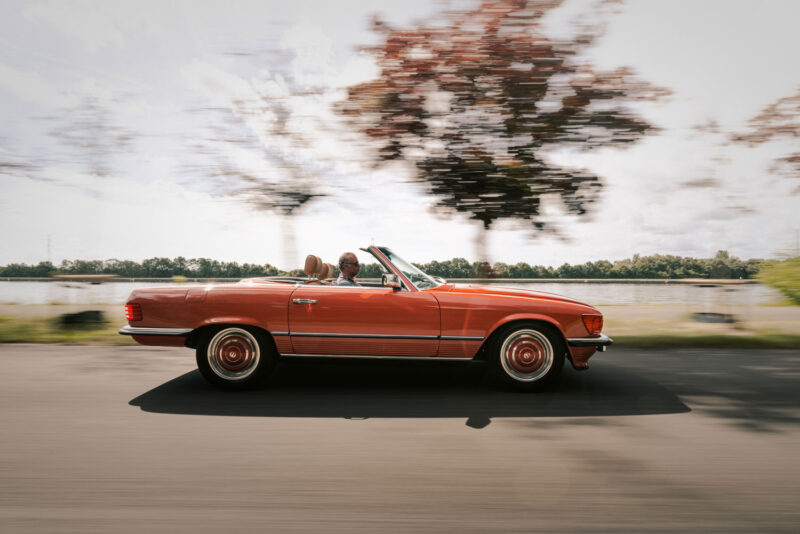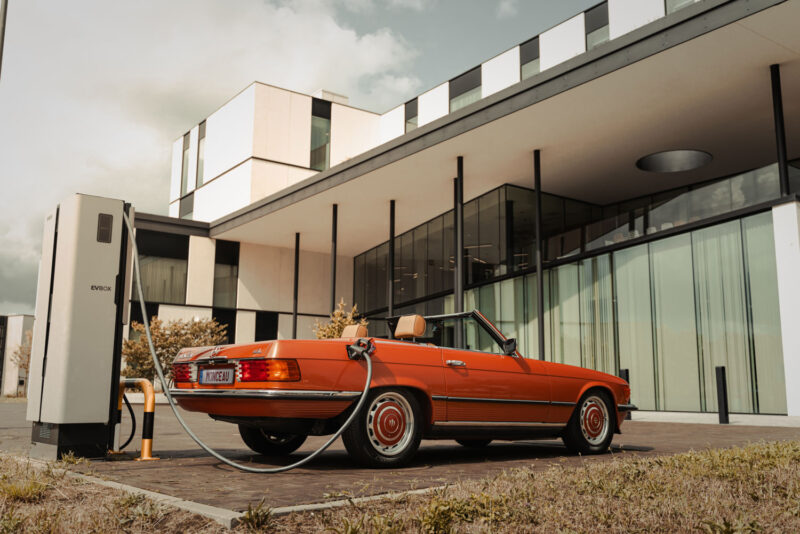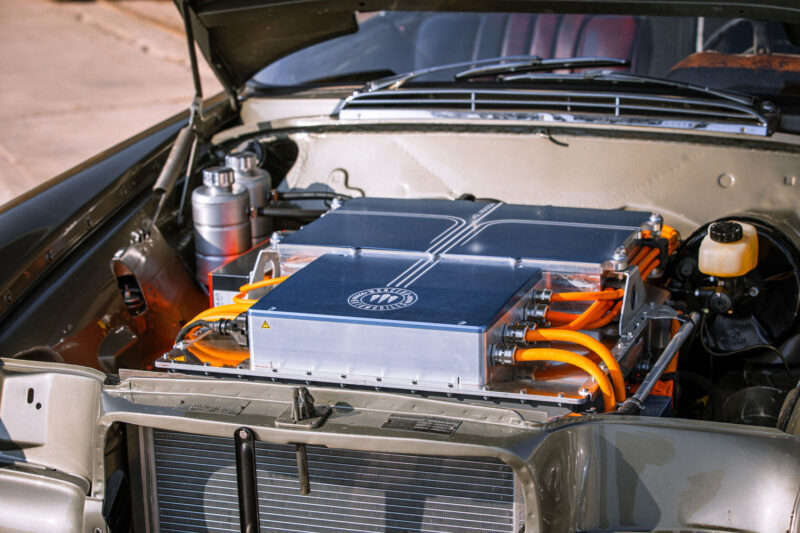
Hot Topic
Classic Car EVs: Smart or Sinful?
Vintage autos are now able to go electric. But should they?
If a vintage Porsche revs its engine in the forest and no one hears it, is it still cool?
That is the nuts and bolts of a debate dividing car restoration culture like some kind of Grease Lightning-ed civil war. One on side you have those who say replacing teeth-rattling combustion engines with whisper-quiet electric motors in classic cars is awesome. On the other side? People who call it an abomination.
Now, for anyone whose car culture exposure is limited to handing over a credit card at Jiffy Lube, you may be thinking, “Um, who cares?” Well, the engine is widely regarded as the heart and soul of a vehicle. So gearheads care. They care a lot.

“The engine is the thing that gives a car its personality,” says Eddie Alterman, Chief Brand Officer of Hearst Autos and former Editor-In-Chief of Car and Driver. To him and other auto originalists, an engine’s whirs and rumbles and clunks and clinks speak a language ten times sexier than anything you’d hear on Emily in Paris. “Those noises are telling you all kinds of things—the health of the car, when to shift, how to drive it,” he explains. “So by putting in an electric motor, you’re removing an amazing piece of interaction between the driver and the machine.” Eddie pauses, and then adds just so there is no chance of misunderstanding, “I’m not a fan.”
Admittedly, too, vintage car conversion is still a niche market. “A 2022 Hagerty survey of 25,000 U.S. car enthusiasts and members found that only one percent had converted their classic to EV,” notes Brian Rabold, Hagerty’s Vice President of Automotive Intelligence.
But Ares Mathevossian, the co-founder of electric car conversion company Dynam Labs in Glendale, CA, says purists need to pump the brakes on the hate. “It’s the new age of hot rodding,” he claims.
Ares and his car-crafting partner have built a business based on the growing classic-to-EV market, and he says that the hardest part of their high-tech builds is giving the cars back to their customers. “I took a Porsche 911 we electrified out for a ride and, man, you hit the pedal and the acceleration is just diabolical and the ride is so smooth. I called my customer and told him I’m keeping it.” As for pressing the mute button on the engine’s signature sound? “I guess you might miss it,” he admits, “but I guarantee no one is missing leaking oil lines of old combustion engines. And if you live in California, you’re definitely not missing smog tests.”
Ian James Corlett, a self-described “semi-famous” voice actor (he was the original voice of Goku on Dragon Ball Z) is firmly in the EVs-for-Everyone camp. Corlett, who says he is a “Porsche guy,” currently cruises around Palm Springs in a 1966 Porsche 912 that he painstakingly restored and electrified over the course of about a decade.
“I bought a real piece of shit in Arizona,” he explains. “We pulled the engine and sold it to some guy in Germany, which basically covered my cost of buying the thing.” From there, it was a long process of getting it to look like a stock 1966 Porsche 912 on the outside while electrified on the inside. “I love when you drive it, you’ll see people on the street spot this nice shiny little rubber bullet coming by. And then they realize, ‘Wait, that didn’t make any noise!’”


Going electric is costly, but that cost varies wildly depending on how much performance you want to get out of the motor—generally anywhere from $50,000 to $100,000. One of Mathevossian’s Porsche EV builds is going to cost about $95,000. That’s buying the motor, battery pack and all necessary parts plus labor.
Once you actually build it, maintenance is easier and costs are lower. Finding replacement parts for very old engines is time-consuming and costly. And things that were built 60 years ago are obviously going to be more prone to breaking and leaking than a brand new motor. “This is a way to keep these classic cars on the road,” Mathevossian continues. “I’ve got a suicide-door Lincoln Continental. It had a 7-liter V8 engine that made 170 horsepower. Nobody’s ever going to miss the oil leaks on that.”
As divided as their opinions may be, one facet that everyone I spoke with can agree on is that electrifying classic cars has nothing to do with protecting the environment. Given the mining practices for rare battery materials and other factors, Mother Earth is not a big winner in this race.
“I’m not a tree hugger type,” says Corlett. “This is really about what is the best technology to power something. Did you know that electric cars have basically been around for as long as gas-powered ones? Even though electric cars were better, somehow gas won out. It’s kind of like VCR and Betamax. Betamax was better and it’s the same with electric cars—the performance of an electric motor just cannot be matched.”
But much like an EV motor’s sound, Alterman won’t hear of the performance argument. “That’s like taking Paul Newman’s Daytona Rolex and ripping out the guts and putting an Apple Watch inside.” Modern EVs are great, he says, but when it comes to vintage cars, it’s all about preserving integrity. “They’re time capsules. And when you drive them, the smells and sounds transport you to the day they rolled off the line.”
If you’re not sure where you stand on pushing the limits of performance vs. preserving the past, Ares brings up a point that may grind your internal debate to a screeching halt. It doesn’t have to be a binary decision, he notes, citing that most of his clients have both types in their garages. But if you only have room for one ride? “I don’t think you’re going to go drop $150,000 on building yourself an EV classic Porsche 911 for your only car,” he says. “That just doesn’t make any sense.”
Hero photo by Eleganza/Getty images



